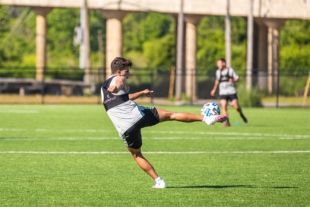Photo courtesy Philadelphia Union
At last report Philadelphia Union II remains virus-free in its own environment while the first-team is away in Florida.
It needs to continue to do so, as does the first team. The player development issue is “loanability” between the two once the Union are back in Chester.
Followers of Bethlehem Steel FC will remember that head coach Brendan Burke once told reporters about going to bed Saturday night thinking his team was set for Sunday afternoon’s tap, only to wake to a roster change.
At the moment surprise over such last-minute changes would seem medically laughable, given that solid confidence of being virus-free costs either two full weeks of quarantine or repeated negative tests over time.
Union II head coach Sven Gartung explained on June 29 that his side could not have conducted a mixed scrimmage with the first team because of its pre-travel isolation.
He further revealed the problem through two points on July 8:
- He explained that migration between the USLC team and Academy teams is not expected to happen this season, partly because the new Academy player development platform is still forming but also because of the virus.
- He does not know what the protocols will be for players like Cole Turner, Matt Freese, and Jack de Vries to be loaned down to his team once they returned from Florida .
He jokingly hoped the trio would never be coming down. He explained wanted them to do well enough down south that they would stay with the first team for game minutes. But he may have been telegraphing another changing expectation. Whatever the trio’s details, the sober truth is that three different levels of play, which in earlier times have had free interchange to “play up” or “play down,” are probably now impenetrably separated.
Two-week quarantines for every loan to the farm team are unworkable. The heart of the matter is that the first-teamer would lose two weeks of practice at his developmentally necessary level every time he moved between groups. That would be two weeks before and two weeks after every single move. That 90 minutes of game time wold cost 24 days of practice is unlikely to be acceptable to Ernst Tanner.
To restore free movement between the first-team and the farm-team, the isolated groups would have to unite medically. But enlarging the group enlarges the risk. And the risk does not expand arithmetically.
The organization’s dilemma recalls Meryl Streep in Sophie’s Choice. “Loanability” is fundamental to player development, but so is continued life and ongoing health.
A major purpose of the organization’s considerable player development investment is to provide game minutes to young Union reserves who are advanced enough to need first-team practice but not yet able to earn first-team game minutes. Michee Ngalina has illustrated the idea for the last season and a half, hopefully now in the past tense. But the imperatives of player development and medical health and safety remain mutually contradictory.
We know how Gartung expects the lower-level interface, between the Academy and Union II, to play out. He said a week ago that he had a squad of 29 players, not counting Turner, Freese and de Vries. He said those players would be with him not the academy. No others would be coming up. If his predicted number pans out, and his assumption that no one new from outside will join, Gartung will have nearly half of the rising U16/17s on his squad should all other assumptions behind the calculation also prove correct.
The upper-level interface is not as clear. We do not know whether staying virus-free in the “bubble” during the first-team’s sojourn in Florida would qualify as the quarantine to protect Turner, Freese, and de Vries. Far and away the more important, more complex question is how to protect the first-team itself from the three youngsters’ exposure to USLC opponents. They would be practicing everyday with their Union teammates after having played for Union II against USLC opponents who are under USLC virus -prevention protocols. They would be expose their teammates to those USLC competitors.
We do not know how the procedures of the two leagues compare, and we make no claim to be qualified to judge. But compare the rigorous social distancing seen in Marjorie Elzey’s photographs of Subaru Park’s watch party for the Union-NYC FC match to the video of the standing space at Lynn Family Stadium in Louisville this past Sunday, where the Lou City supporters’ groups were. The images contrast. Kentucky’s governor is not Delaware County’s health authority.
And, we have not carefully explored a second developmental question. How will busing instead of flying during three consecutive sets of three games in eight or nine days affect the Union II’s quantity of practice time? Gartung has already stated that the standard practice of the last four years, to have a second practice two or three days out of a normal seven-day week, will not be possible. A return travel day will be followed by a necessary rehabilitation one, and those two will then approach closely to the next scheduled day of departure.
Resumption of play in both professional leagues cannot mean restoration of the old player development techniques as they were before the pandemic.
“Playing up” or “down” seems gone for the pre-vaccine future.
We’ll get our first glimpse of how Union II look in this era on Saturday night, taking on Pittsburgh at 7:30 p.m. in an empty Subaru Park.


Comments